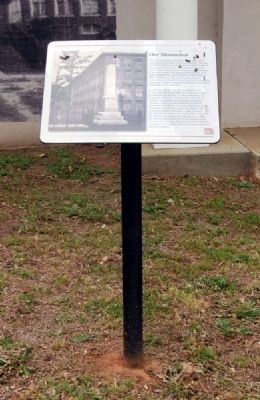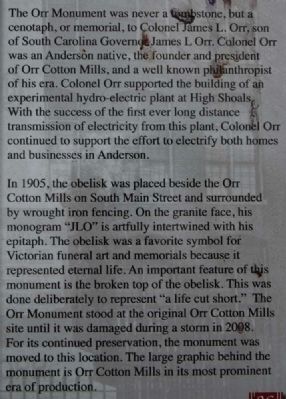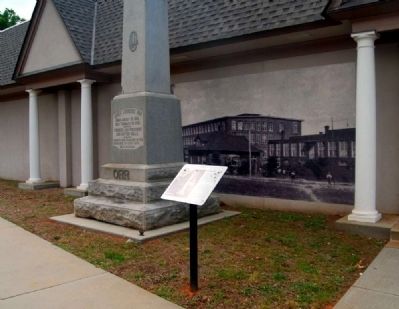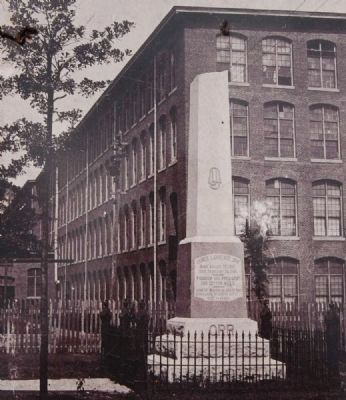Anderson in Anderson County, South Carolina — The American South (South Atlantic)
Orr Monument
The Orr Monument was never a tombstone, but a cenotaph, or memorial, to Colonel James L. Orr, son of South Carolina Governor James L. Orr. Colonel Orr was an Anderson native, the founder and president of Orr Cotton Mills, and a well known philanthropist of his era. Colonel Orr supported the building of an experimental hydro-electric plant at High Shoals. With the success of the first ever long distance transmission of electricity from this plant, Colonel Orr continued to support the effort to electrify both homes and businesses in Anderson.
In 1905, the obelisk was placed beside the Orr Cotton Mills on South Main Street and surrounded by wrought iron fencing. On the granite face, his monogram "JLO" is artfully intertwined with his epitaph. The obelisk was a favorite symbol for Victorian funeral art and memorials because it represented eternal life. An important features of this monument is the broken top of the obelisk. This was done deliberately to represent 'a life cut short." The Orr Monument stood at the original Orr Cotton Mills site until it was damaged during a storm in 2008. For its continued preservation, the monument was moved to this location. The large graphic behind the monument is Orr Cotton Mills in its most prominent era of production.
Erected 2010 by Anderson County Museum.
Topics. This historical marker and monument is listed in this topic list: Industry & Commerce. A significant historical year for this entry is 1905.
Location. 34° 30.6′ N, 82° 38.95′ W. Marker is in Anderson, South Carolina, in Anderson County. Marker is on East Greenville Street (State Highway 81), on the left when traveling south. Touch for map. Marker is at or near this postal address: 202 East Greenville Street, Anderson SC 29621, United States of America. Touch for directions.
Other nearby markers. At least 10 other markers are within walking distance of this marker. James Lawrence Orr (here, next to this marker); Boy High School (here, next to this marker); "Old Reformer" Cannon (a few steps from this marker); Girls High School (within shouting distance of this marker); The Old Reformer (within shouting distance of this marker); Robert Anderson Memorial Fountain (within shouting distance of this marker); Frierson School House (within shouting distance of this marker); McGee Harness Shop (about 300 feet away, measured in a direct line); Virginia "Jennie" Gilmer (approx. 0.2 miles away); Anderson County Library (approx. ¼ mile away). Touch for a list and map of all markers in Anderson.
Also see . . .
1. Cenotaph. A cenotaph is an "empty tomb" or a monument erected in honour of a person or group of people whose remains are elsewhere. (Submitted on May 8, 2011, by Brian Scott of Anderson, South Carolina.)
2. Governor James Lawrence Orr. James Lawrence Orr (May 12, 1822 – May 5, 1873) was an American politician who served as Speaker of the United States House of Representatives in the United States Congress. (Submitted on May 8, 2011, by Brian Scott of Anderson, South Carolina.)
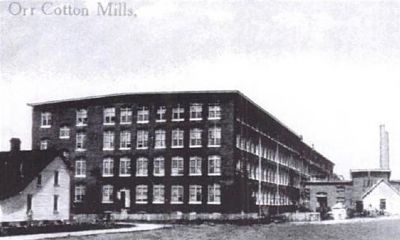
South Carolina Postcards, Vol. IX: Anderson County, by Howard Woody
5. Orr Cotton Mills
In 1906 Orr Mill had 57,496 spindles and 1,504 looms, consumed 11,000 bales of cotton, and produced print cloths valued at $1 million. Orr Cotton Mills was incorporated in 1899 by J.L. Orr. It employed 700 operatives and had a $175,000 payroll.
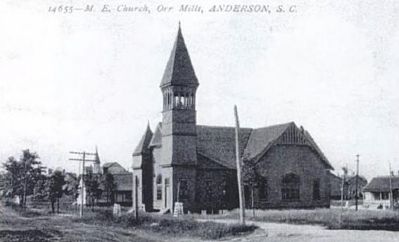
South Carolina Postcards, Vol. IX: Anderson County, by Howard Woody
6. Methodist Episcopal Church, Orr Mills
The Methodist Episcopal Church on South Main Street is shown on the postcard scene above. It is one of the two Orr Mill churches that the mill built for the operatives. Directly behind the Methodist Church is the Baptist Church. The mill gave the lots, 15 percent of the construction costs, and $100 each annually for expenses. Rev. S.T. Creech was the pastor of this Methodist Church in 1905.
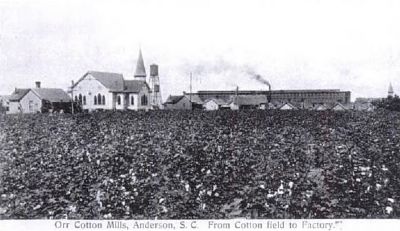
South Carolina Postcards, Vol. IX: Anderson County, by Howard Woody
7. Orr Cotton Mills, from Cotton Field to Factory
This view with the cotton field symbolized the cycle of mill economics. Farmers grew and sold cotton; cotton was turned into fabric at the mill; and jobs were thus created for operatives. The mills supported churches and schools and contributed taxes to both local and state governments. The village Baptist Church, shown above the left side, had a membership of 254 in 1909 and Rev. H.C. Martin was the pastor.
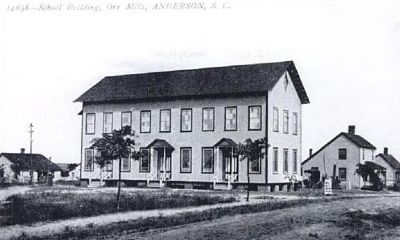
South Carolina Postcards, Vol. IX: Anderson County, by Howard Woody
8. School Building, Orr Mills
The mill owners wanted operatives with a high educational level. August Kohn's book, Cotton Mills of South Carolina, called that "welfare work." This concept caused the directors to build schools with academic and industrial subjects, churches, meeting halls, and gyms. Orr Mills spent $1,000 for a 3-teacher school building for 547 students. M. O'Neal, principal, and two other teachers taught at this school in 1905.
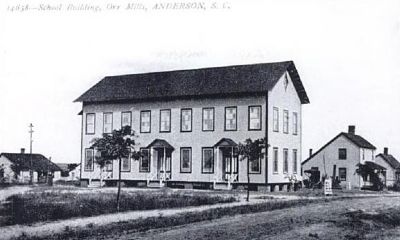
South Carolina Postcards, Vol. IX: Anderson County, by Howard Woody
9. School Building, Orr Mills
The mill owners wanted operatives with a high educational level. August Kohn's book, Cotton Mills of South Carolina, called that "welfare work." This concept caused the directors to build schools with academic and industrial subjects, churches, meeting halls, and gyms. Orr Mills spent $1,000 for a 3-teacher school building for 547 students. M. O'Neal, principal, and two other teachers taught at this school in 1905.
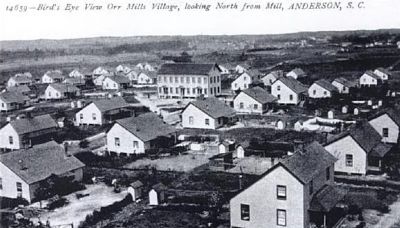
South Carolina Postcards, Vol. IX: Anderson County, by Howard Woody
10. Bird-s Eye View of the Orr Mill Village
Looking North from Mill
Looking North from Mill
This bird's-eye view of the Orr Mill Village shows the standard layout of a village with identical one-story cottages for small families and two-story structures for larger ones. In 1906 the village had a 1,500 population. The privies were located at the rear of each lot with a wagon path running between them for the entire distance of a street.
Credits. This page was last revised on October 14, 2020. It was originally submitted on May 8, 2011, by Brian Scott of Anderson, South Carolina. This page has been viewed 1,359 times since then and 106 times this year. Photos: 1, 2, 3, 4. submitted on May 8, 2011, by Brian Scott of Anderson, South Carolina. 5, 6, 7, 8, 9, 10. submitted on September 22, 2010, by Brian Scott of Anderson, South Carolina.
